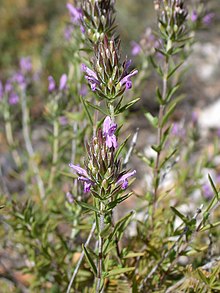| Revision as of 02:27, 6 January 2025 editDavidbena (talk | contribs)Extended confirmed users57,403 edits linking← Previous edit | Revision as of 02:34, 6 January 2025 edit undoDavidbena (talk | contribs)Extended confirmed users57,403 editsNo edit summaryNext edit → | ||
| Line 51: | Line 51: | ||
| ] | ] | ||
| ] | ] | ||
| ] | |||
Revision as of 02:34, 6 January 2025
Species of plant
| Thymbra spicata | |
|---|---|

| |
| Scientific classification | |
| Kingdom: | Plantae |
| Clade: | Tracheophytes |
| Clade: | Angiosperms |
| Clade: | Eudicots |
| Clade: | Asterids |
| Order: | Lamiales |
| Family: | Lamiaceae |
| Genus: | Thymbra |
| Species: | T. spicata |
| Binomial name | |
| Thymbra spicata L. | |
| Synonyms | |
| |
Thymbra spicata, also commonly known as Spiked savoury, Spiked thymbra and Thyme spike, is a perennial-green dwarf shrub of the family Lamiaceae, native to Greece, Turkey, Syria, Lebanon, Israel (Palestine), Iraq and Iran, having erect stems bearing strongly scented leaves, rich in polyphenols such as rosmarinic acid, carvacrol (CVL) and different flavonoids.

Description
Thymbra spicata resembles Satureja thymbra in the shape and color of its leaves (the former tending to be more linear and arranged in a crisscross pattern), and is quite close to it in the color, size, and shape of its flowers. However, the flowers in this shrub are not arranged in nest-like clusters, as in Satureja thymbra, with gaps between them in leaps, but are crowded together in a dense raceme at the top of the stem. The petiole of the plant is extremely long and narrow (9–12 mm long). The plant reaches a height of 20–30 cm.
The leaves are covered with tiny glandular hairs, and their edges have long cilia. The flowers are bright lilac in color, blossoming between April and June (in Israel) and between June and August (in Turkey). The flowers are arranged at the ends of the stems in dense oval inflorescences that lengthen as they ripen. The plant's leaf glands secrete essential oils, which give to Thymbra spicata its pungent odor. For this reason, the plant is used as a spice (some add it to the spice mixture zaatar), but it is too pungent for making tea.
in Arabic, the plant is known as za'tar sebel (زعتر سبل).
Habitat
Garrigues are the natural habitat of Thymbra spicata. The plant is typical of exposed marlstone and chalk patches in the mountains, where it accompanies thyme or dominates independent patches. It prefers dry sunny hillsides and high dry meadows. In Israel, the plant is protected under Israeli law.
Anti-bacterial properties
The presence of high levels of phenolic components found in the plant are thought to endow the plant with special antibacterial and antioxidant properties. Its practical use and application in agronomy and in medicine, however, has yet to be fully utilized.
References
- Hassler, Michael. "World Plants - Plant List". World Plants. Synonymic Checklist and Distribution of the World Flora. Retrieved 1 August 2024.
- Nutritional and Physiological Properties of Thymbra spicata: In Vitro Study Using Fecal Fermentation and Intestinal Integrity Models, National Library of Medicine
- ^ Hareubeni, Efraim; Hareubeni, Hanna (1949). "The Hyssops: The Roman Hyssop, the Wild one, and the Blue one". Tarbiz (in Hebrew). 21 (1). Mandel Institute for Jewish Studies: 43–44. JSTOR 23585798.
- ^ Shmida, Avi (2005). MAPA's Dictionary of Plants and Flowers in Israel (in Hebrew). Tel-Aviv: MAPA Publishers. p. 349. OCLC 716569354., s.v. Thymbra spicata
- Toncer, Ozlem; Karaman, Sengul; Diraz, Emel; Sogut, Tahsin; Kizil, Suleyman (2016). "Diurnal Variation Effects in Essential Oils of Wild Thyme (Thymbra spicata var. spicata L.) Under Cultivation Conditions". Journal of Essential Oil Bearing Plants. 19 (8). Co-published with Har Krishan Bhalla & Sons: 2037–2048. doi:10.1080/0972060X.2016.1252694.